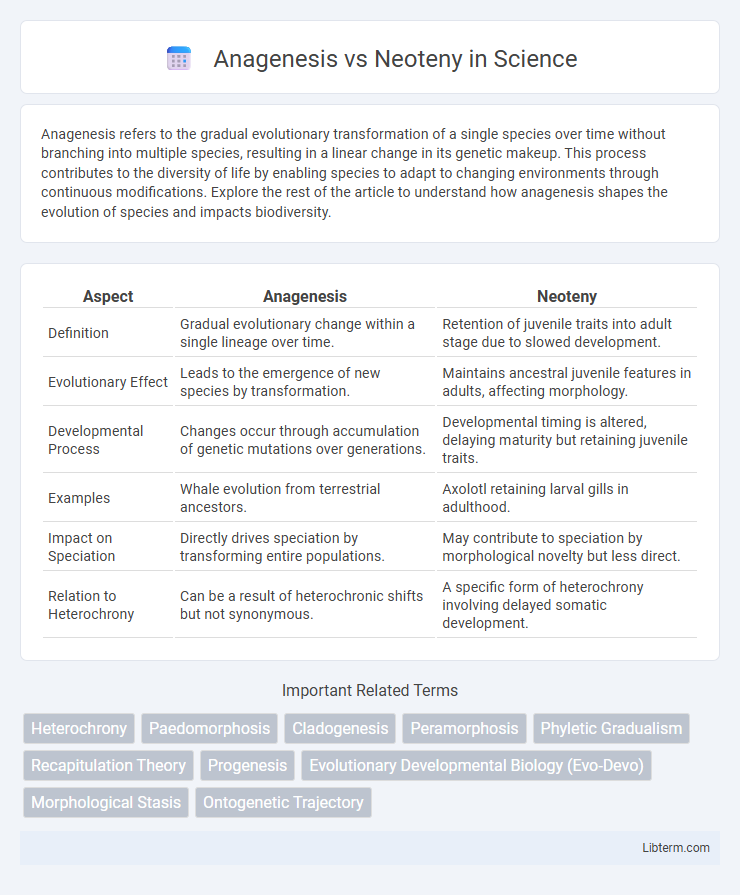Anagenesis refers to the gradual evolutionary transformation of a single species over time without branching into multiple species, resulting in a linear change in its genetic makeup. This process contributes to the diversity of life by enabling species to adapt to changing environments through continuous modifications. Explore the rest of the article to understand how anagenesis shapes the evolution of species and impacts biodiversity.
Table of Comparison
| Aspect | Anagenesis | Neoteny |
|---|---|---|
| Definition | Gradual evolutionary change within a single lineage over time. | Retention of juvenile traits into adult stage due to slowed development. |
| Evolutionary Effect | Leads to the emergence of new species by transformation. | Maintains ancestral juvenile features in adults, affecting morphology. |
| Developmental Process | Changes occur through accumulation of genetic mutations over generations. | Developmental timing is altered, delaying maturity but retaining juvenile traits. |
| Examples | Whale evolution from terrestrial ancestors. | Axolotl retaining larval gills in adulthood. |
| Impact on Speciation | Directly drives speciation by transforming entire populations. | May contribute to speciation by morphological novelty but less direct. |
| Relation to Heterochrony | Can be a result of heterochronic shifts but not synonymous. | A specific form of heterochrony involving delayed somatic development. |
Introduction to Anagenesis and Neoteny
Anagenesis refers to the evolutionary process where a single species gradually accumulates genetic changes over time, resulting in the transformation into a new species without branching. Neoteny involves the retention of juvenile traits in the adult form, often influencing developmental timing and morphology. Both mechanisms play crucial roles in evolutionary biology by shaping species adaptation and diversification.
Defining Anagenesis: Evolutionary Lineage Transformation
Anagenesis refers to the evolutionary process where a single lineage undergoes gradual genetic and phenotypic changes over time, resulting in the transformation of an entire species without branching. This contrasts with cladogenesis, where a lineage splits into distinct new species. Anagenesis emphasizes continuous, linear evolutionary change within a population, often leading to increased adaptation and morphological divergence from ancestral forms.
Understanding Neoteny: Retention of Juvenile Traits
Neoteny describes the retention of juvenile features into adulthood, a process crucial for evolutionary adaptability and species diversity. This biological phenomenon contrasts with anagenesis, where species gradually transform without retaining juvenile traits. Understanding neoteny involves studying genetic mechanisms that delay or alter developmental stages, impacting morphology and behavior in species such as axolotls and humans.
Key Differences Between Anagenesis and Neoteny
Anagenesis involves the gradual accumulation of genetic changes leading to the evolutionary transformation of a species into a new form, whereas neoteny refers to the retention of juvenile traits into adulthood, affecting development rather than species-level change. Anagenesis results in speciation through genetic divergence over generations, while neoteny impacts an organism's morphology and behavior without necessarily producing new species. The key difference lies in anagenesis driving evolutionary lineage change, while neoteny modifies growth patterns within a species.
Evolutionary Mechanisms Underlying Anagenesis
Anagenesis involves the gradual accumulation of genetic changes within a single lineage, leading to a transformation in species traits without branching speciation. Genetic drift, natural selection, and mutation drive these phenotypic shifts, resulting in directional evolutionary change. Neoteny, in contrast, emphasizes paedomorphic development where juvenile characteristics are retained in adults, highlighting developmental timing modifications rather than lineage-wide genetic changes.
Biological Implications of Neoteny
Neoteny, the retention of juvenile traits into adulthood, significantly influences evolutionary biology by altering developmental timing and promoting morphological diversity within species. Unlike anagenesis, which involves gradual evolutionary change within a lineage, neoteny enables species to adapt through paedomorphic characteristics that affect reproductive strategies and ecological niches. This process impacts growth rates, hormone regulation, and phenotypic plasticity, driving speciation and influencing evolutionary trajectories in various taxa.
Examples of Anagenesis in the Fossil Record
Anagenesis in the fossil record is exemplified by the gradual evolutionary transformation of the horse lineage, showing a continuous morphological change from small, multi-toed ancestors like Eohippus to the modern one-toed Equus. Another clear case is the transition of early hominins, such as Australopithecus, evolving into Homo erectus, demonstrating steady anatomical changes without branching. These examples highlight how anagenetic evolution leads to species modification over time via fossil evidence.
Notable Cases of Neoteny in Modern Species
Neoteny, the retention of juvenile features in adult organisms, is notably observed in species like the axolotl, which retains its larval gills throughout life while reaching reproductive maturity. Other examples include the domesticated dog, which exhibits juvenile wolf traits such as floppy ears and reduced aggression, illustrating neoteny's role in evolution through developmental timing shifts. This contrasts with anagenesis, where species undergo gradual morphological changes without juvenile characteristic retention.
Impact of Anagenesis and Neoteny on Biodiversity
Anagenesis drives biodiversity by transforming entire species through gradual genetic changes, leading to new species without branching, which can reduce species diversity but increase functional diversity within lineages. Neoteny promotes biodiversity by retaining juvenile traits into adulthood, enabling populations to exploit different ecological niches and encouraging speciation through heterochronic shifts. The interplay of anagenesis and neoteny shapes evolutionary pathways, influencing species richness and ecosystem versatility across various taxa.
Conclusion: The Significance in Evolutionary Biology
Anagenesis represents the gradual evolutionary transformation within a lineage without branching, while neoteny involves the retention of juvenile traits into adulthood, influencing developmental timing and morphology. The significance in evolutionary biology lies in understanding how these processes contribute to species diversification and adaptation, with anagenesis driving continuous morphological change and neoteny enabling the emergence of novel phenotypes. Recognizing the roles of anagenesis and neoteny enhances insights into evolutionary mechanisms shaping biodiversity and the evolutionary potential of organisms.
Anagenesis Infographic

 libterm.com
libterm.com